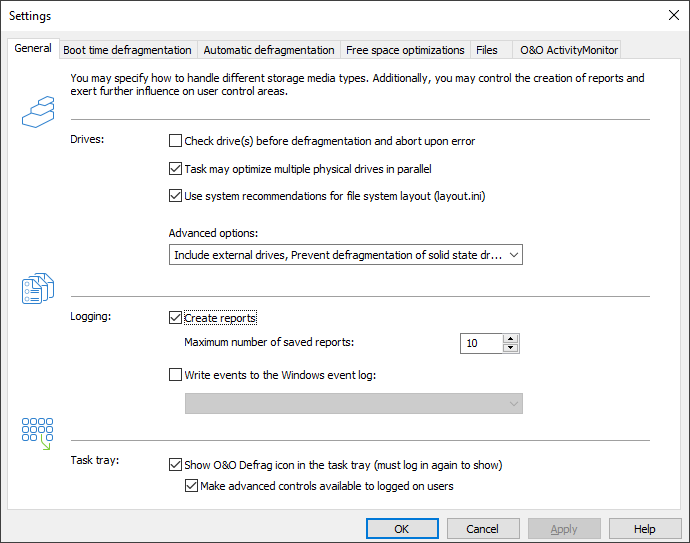The settings control the behavior of O&O Defrag during analysis and defragmentation.
Chkdsk before the defragmentation and cancel if errors are found
You can have O&O Defrag check the integrity of your drives before a defragmentation. You can have O&O Defrag check the integrity of your drives before a defragmentation. This check is like the Windows chkdsk function but errors that are found will not be corrected. These need to be corrected manually using the chkdsk function.
A test of the connected drives in Windows can also be run manually. It is strongly recommended to thoroughly check a drive if an error is detected. More information can be found in the Windows Help file.
Defragment several physical data volumes at the same time
You can defragment your drives either parallel or sequentially. Sequential defragmentation means that one drive will be defragmented after the other, in alphabetical order.
During parallel defragmentation, partitions that are located physically on different hard disks are processed at the same time. This shortens the total time needed for defragmentation but leads to a higher system load by O&O Defrag. If you only have one hard disk in your computer, all partitions on it will be defragmented sequentially.
Considering the system parameters on how to allocate files.
Only valid for Windows 7: The layout.ini file is used as reference during defragmentation to allocate files optimally on the hard disk. The optimal sequence for start files proposed by the operating system will be considered in order to initiate the system start as quick as possible.
Under Advanced optionsyou may modify additional functional aspects of O&O Defrag:
- Include removable drive
Removable drives (e.g. ZIP, Jaz or DVD RAM) can also be defragmented. - Include external drives
It is also possible to defragment drives that are connected by an external interface, such as a USB or FireWire. - Show defragmentation summary
Normally, after each defragmentation, a popup presenting a ClusterView before and after defragmentation with fragmentation statistics is shown.You may deactivate this feature if you would like to suppress the summary popup. - Protect SSD drives from defragmentation
SSD-drives are subject to physical wear out of flash chips and this might be made worse by defragmentation. Because of their special construction, defragmentation will not increase performance of SSDs. They should not be defragmented, also see "Optimizing Solid State Drives". - File into zones
This option is disabled by default.If enabled, during defragmentation files will be placed in different hard drive areas (speed zones) according to specific file access patterns; for more information please refer to zones. - Disable automatic optimization
Automatic optimization is enabled by default.You may activate this function to prevent O&O Defrag from automatically optimizing your hard drives in the background.
Enable remote administration from same network
This feature is disabled by default.Upon enabling, all users from the same network are granted remote access to O&O Defrag on your computer.Your firewall will be automatically configured to allow incoming connections to the O&O Defrag service on your computer.You may find additional information in Work within the network.
Reports and Logging
You can create status reports in an HTML format. A maximum of 999 reports can be created and saved.
Please enable this function if you want to log all O&O Defrag activities into the Windows Event log. You can specify the detail level for the notification - whereby level 1 only logs errors and level 4 stores all the information available. Please bear in mind that this might lead to many log entries, which in turn overwrite entries by other programs or systems.
Tasktray
If you wish, the O&O Defrag icon may be placed on the tasktray to display the status of defragmentation.
The logged- in user may optionally use the advanced control possibilities.
Please, see also the chapter "Tray icon (notification area icon)" for further information about the tray icon.
Settings for the Tray icon
Under Setting/General in the user interface you can specify various control possibilities for the tray icon.
Display the O&O Defrag icon in the notification area
This option allows you to set whether the TrayIcon should be displayed or not. If you change this option, you will need to login again to validate the new settings.
Enable enhanced control for logged in users
You can allow the logged in user to pause the defragmentation or to stop it completely. If you disable this option, the user will only receive information on the running defragmentation, he will not be able to control it.

General settings